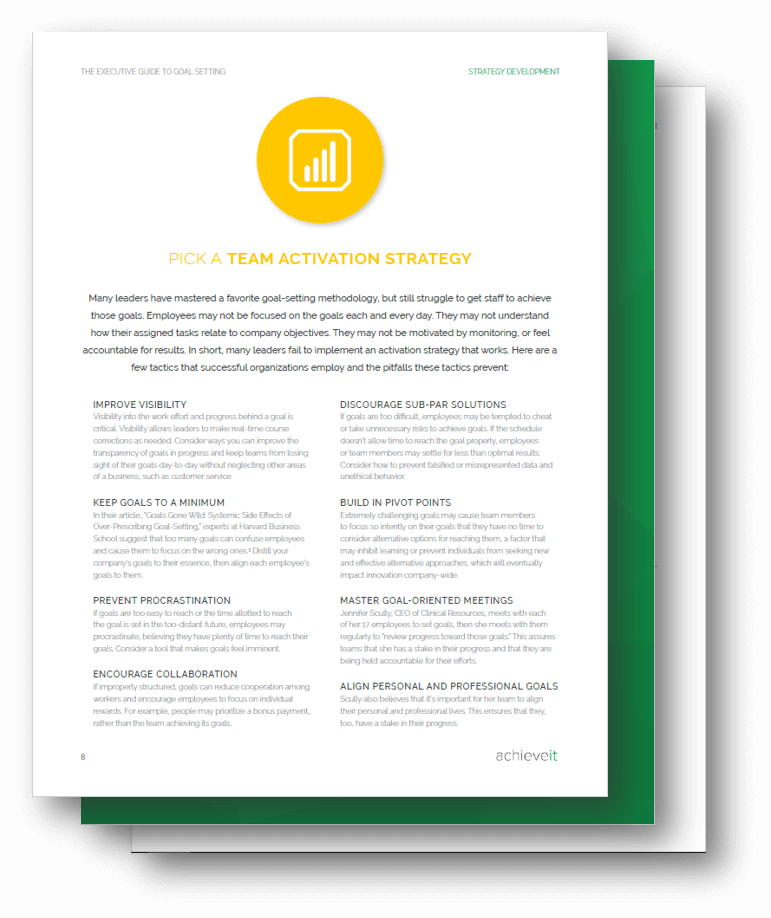Several years ago, I was tasked with building project management governance at a rapidly growing company. What started as sticky notes and spreadsheets grew into a full-fledged PMO with a robust portfolio of diverse projects.
As the PMO evolved, strategic planning was the clear next step for the company’s continued growth.
So where did we start? Well, we had an incredible amount of data from our project management software. So, we held a successful Executive off-site to work through key planning exercises. We completed SWOT analyses, competitor and environmental analyses, and vision exercises. All the traditional planning phases.
And all this led us to know exactly where we were and where we wanted to be in 1, 3, and 5 years.
So as the head of project management and strategy, I shifted to execution. I guided the department leads in identifying projects that would align with our goals for the coming year. These goals, and subsequent projects, were well-documented and robustly built.
3 problems in translating project management to strategy execution
So, what was the problem? There must be one otherwise I have written this purely to gloat.
For us, the problem was multifaceted. While we nailed the transition from project management to planning, we had gaps in the planning to the execution process.
And most notably these problems arose in three areas:
1. Our project management software wasn’t intended for strategy execution
2. We mistook assignment & accountability for understanding
3. We misused spreadsheets as our ‘tracking tool’
Hopefully, my lessons can help your organization course-correct during the planning process instead.
Lesson 1 – Project management software is not intended for strategy.
At the time, we had a portfolio of over 35 projects and more than 70 initiatives running concurrently throughout the organization. It should have been easy to see how the work being done aligned with the organization’s strategic goals.
The data was right there. Unfortunately, the data lived in silos.
I spent more hours than I’d like to rehash in Excel, PowerPoint, and our PMIS (Project Management Information System). And unfortunately, I can tell you with absolute certainty that it was not easy.
Project management software is simply that – it manages projects. And it can manage them extremely well. It does not, however, connect the projects to show you the overall health of the portfolio.
Lesson 2 – Having assigned tasks in a project does not mean you understand the goal of the project.
Alignment is incredibly important to project success. The Project Management Institute found that understanding alignment of assignments improves completion rates by over 30%. And up to a 73% completion rate.
Our task owners, the doers of any organization, often get the short end of the stick. While they own the ‘work’, they rarely understand the connection of their work to the greater good. This is a detriment to them, their work, and the organization’s potential.
This lack of strategic visibility slowed our progress and created uncertainty in the prioritization of their daily work.
Lesson 3 – Spreadsheets suck as your tracking tool.
Excel does a lot of things well. Pivot tables, complex formulas, simple calculations. But Excel isn’t any smarter than the data you add to it or the people managing this data.
So, what happens when someone “mis-clicks”? Or when someone updates departmental metrics in another department’s tab? Goodbye data and the last quarter’s worth of updates.
Beyond the dangers of shared files, gleaning insights from spreadsheets is nearly impossible.
Are we on track or off track? How do all these line items connect to our goals? The list of challenges here goes on and on.
So, while we were tracking everything, that data wasn’t doing us any good. And it certainly wasn’t accessible to our teams.
FREE RESOURCE
Executive Guide to Strategic Goal Setting
Download this guide to learn how the most successful executives use goal-setting methodologies and technology to empower their teams and improve execution.

Partnering project management with strategic execution
Projects play a critical role in driving organizational growth. But four critical factors play an even greater role in strategic growth and execution:
- Alignment
- Accountability
- Collaboration
- Visibility
Now the project management software we were using did check the box on accountability and collaboration but not enough. And it didn’t even touch alignment and visibility. Our spreadsheets and slide decks weren’t going to close that gap either.
Leaving these four drivers of execution unaccounted for ties directly to the problems detailed above.
We needed a strategic, birds-eye view. One that ensured organizational alignment and clear visibility on statuses and ownership.
The move from a project management perspective to one more focused on strategic execution must be intentional. And it absolutely requires the tools needed to ensure top-down and lateral visibility.
Project management is the cornerstone of any successful organization. It affords us the awareness, understanding, and balance required of competing timelines, resources, and interests. Unfortunately, the tools most often associated with project management simply do not work for strategic execution.
Project management is focused on the granular. To ensure strategic execution you must also focus on the upper-most levels. These tools must work together to take your organization from good to great. But one tool is unlikely to replace the other. They must work together.
It is precisely this paradox that led me to AchieveIt. The gaps experienced in accountability and collaboration across the portfolio and the strategic plan are solved through automated updates and streamlining from multiple tools down to one. Organizational and strategic alignment become innate. The design and customized visibility ensure all team members share a common goal. And all team members have clarity on how their work benefits their organization’s success.
Project management and strategic planning are two sides of the same coin. They benefit from each other’s expertise and point of view.
To truly see your organization succeed, to go from good to great, take a project management approach to your strategic execution.



